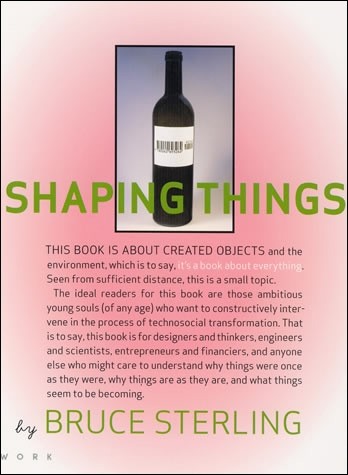Howard Rheingold: The Virtual Community: Homesteading on the Electronic Frontier (1993)
Filed under book | Tags: · community, cyberspace, internet, network culture, virtual communities

“In this book, Howard Rheingold tours the ‘virtual community’ of online networking. He describes a community that is as real and as much a mixed bag as any physical community andmdash;one where people talk, argue, seek information, organize politically, fall in love, and dupe others. At the same time that he tells stories about people who have received online emotional support during devastating illnesses, he acknowledges a darker side to people’s behavior in cyberspace. Indeed, contends Rheingold, people relate to each other online much the same as they do in physical communities.”
Publisher Addison-Wesley, Reading, MA, 1993
William Patrick Book series
ISBN 9780201608700, 0201608707
ix+325 pages
Interview with author (Katie Hafner, WELL, about 2nd edition, 2000)
Reviews: Geert Lovink (Mediamatic, 1993), John Stimson (Social Science Computer Review, 1995), P.A. Dee Southard (Social Science Computer Review, 1995), Douglas B. Hindman (J Applied Communications, 1996), Scott London (c.1993), Ian Goodwin (Westminster Papers in Communication and Culture, 2004).
Analysis: Fred Turner (Technology & Culture, 2005).
Sam Williams: Free as in Freedom: Richard Stallman’s Crusade for Free Software (2002)
Filed under book | Tags: · copyleft, floss, free software, hacker ethic, open source, software

“Free as in Freedom interweaves biographical snapshots of GNU project founder Richard Stallman with the political, social and economic history of the free software movement. It examines Stallman’s unique personality and how that personality has been at turns a driving force and a drawback in terms of the movement’s overall success. “Free as in Freedom examines one man’s 20-year attempt to codify and communicate the ethics of 1970s era “hacking” culture in such a way that later generations might easily share and build upon the knowledge of their computing forebears. The book documents Stallman’s personal evolution from teenage misfit to prescient adult hacker to political leader and examines how that evolution has shaped the free software movement. Like Alan Greenspan in the financial sector, Richard Stallman has assumed the role of tribal elder within the hacking community, a community that bills itself as anarchic and averse to central leadership or authority. How did this paradox come about? “Free as in Freedom provides an answer. It also looks at how the latest twists and turns in the software marketplace have diminished Stallman’s leadership role in some areas while augmenting it in others. Finally, “Free as in Freedom examines both Stallman and the free software movement from historical viewpoint. Will future generations see Stallman as a genius or crackpot? The answer to that question depends partly on which side of the free software debate the reader currently stands and partly upon the reader’s own outlook for the future. 100 years from now, when terms such as “computer,” “operating system” and perhaps even “software” itself seem hopelessly quaint, will RichardStallman’s particular vision of freedom still resonate, or will it have taken its place alongside other utopian concepts on the ‘ash-heap of history?’
Published by O’Reilly, 2002
ISBN 0596002874, 9780596002879
225 pages
Key terms: GNU Project, Richard Stallman, Unix, Lisp Machine, Linus Torvalds, GNU Emacs, free software movement, AI Lab, operating system, hacker ethic, Free Software Foundation, Sun Microsystems, proprietary software, Steven Levy, GNU Manifesto, source code, Open Publication License, Eric Raymond, Minix, Napster
Comment (1)Bruce Sterling: Shaping Things (2005)
Filed under book | Tags: · design, environment, gadgets, machine, things

“‘Shaping Things is about created objects and the environment, which is to say, it’s about everything,’ writes Bruce Sterling in this addition to the Mediawork Pamphlet series. He adds, ‘Seen from sufficient distance, this is a small topic.’
Sterling offers a history of shaped things. We have moved from an age of artifacts, made by hand, through complex machines, to the current era of ‘gizmos.’ New forms of design and manufacture are appearing that lack historical precedent, he writes; but the production methods, using archaic forms of energy and materials that are finite and toxic, are not sustainable. The future will see a new kind of object—we have the primitive forms of them now in our pockets and briefcases: user-alterable, baroquely multi-featured, and programmable—that will be sustainable, enhanceable, and uniquely identifiable. Sterling coins the term ‘spime’ for them, these future manufactured objects with informational support so extensive and rich that they are regarded as material instantiations of an immaterial system. Spimes are designed on screens, fabricated by digital means, and precisely tracked through space and time. They are made of substances that can be folded back into the production stream of future spimes, challenging all of us to become involved in their production. Spimes are coming, says Sterling. We will need these objects in order to live; we won’t be able to surrender their advantages without awful consequences.”
Designed by Lorraine Wild
Publisher MIT Press, 2005
Mediaworks Pamphlets series
ISBN 026219533X, 9780262195331
149 pages
PDF (updated on 2020-4-12)
Comment (0)
